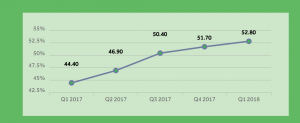Marin Reveals the Secret to Better Understanding of Global Customers, and the Ways in Which the Digital Advertising Landscape Is Evolving
In a recent report, Marin Software revealed that search spend increased by 11% globally, with Eurozone growth outstripping more mature markets like the UK and the US. The report clearly outlines the surge of mobile advertising as we see its inevitable increase in percentage for spend and clicks. However, CPCs are still lower on mobile than desktop, with the discount averaging 33% worldwide.
The opportunity to find the additional volume on mobile remains open across industries.
To dive deep into how brands can better optimize advertising on Search and Social channels for digital advertising, we spoke to industry veteran and SVP of Marketing at Marin Software, Wesley MacLaggan.

Tell us about your role at Marin, and your contribution to the latest report on Digital Advertising Benchmark.
As the SVP of Marketing at Marin Software, I’m tasked with driving awareness around Marin’s core function, which is uniting advertising across search and social channels.
For our Q1 2018 Digital Advertising Benchmark Report, I helped the team gather data from across our customer base to analyze how advertisers are allocating their budgets and getting the best results from their digital ad spend. We often use our benchmark reports to not only get a better understanding of our customers but the industry as a whole and the ways in which the digital marketing landscape is evolving.

What is the true state of “Digital Advertising in 2018”? How are native and programmatic advertising ecosystems coping with brand safety and ad fraud?
We can’t talk about digital advertising without talking about Google and Facebook. These two companies represent 63% of US digital ad spend and, as evident with their latest quarterly earnings reports, show no signs of stopping. Aside from the dominance of the big two, our quarterly benchmark report revealed three key, growing trends: the rise of search, mobile, and dynamic ads:
- Search spend increased by 11% globally, with 30% growth in the Eurozone.
- Mobile now makes up 40% of search spend, representing an increasing share of spend and clicks.
- Dynamic ads increased 37% year over year.
Digital advertising spend continues to grow, but it’s no secret that the industry has been under a data privacy microscope this year. Advertisers want to trust the technology they invest in and make sure their ads are being targeted to the right consumers in the most appropriate and relevant way.
Throughout the industry, advertisers and agencies are calling for transparency from their publishers and ad tech partners, and they’re putting more money towards platforms that will help them achieve their marketing objectives in a brand-safe and ethical manner.
Moving forward, brands will need to demand more from their partners in order to combat brand safety and ad fraud—that includes choosing an ally whose platform will share where their ads are running, what they’re paying for those ads, and what the technology is doing to measure, manage, and optimize their advertising placements.
Should marketers focus more on mobile advertising in 2018?
The simple answer is yes. Our quarterly benchmark report shows a steady increase in mobile in terms of both spend and clicks, and this upward trend will continue in the years ahead. While there is currently a 33% discount on mobile CPCs compared to desktop, this number will likely drop as demand for mobile ads rises.
Technology will continue to improve, and as ad tech becomes more sophisticated and does a better job of linking mobile transactions to the full customer journey, interest will peak and higher CPCs will result. We can even see this trend in full force when looking at Facebook’s Q1 2018 earnings, which show that mobile ads now account for 91% of its total revenue. Search isn’t quite at that level yet, but already the majority of searches are coming from mobile devices.
It’s important for publishers to remember that it’s not just the ad, but the end-to-end customer experience that needs to be optimized. If you’re sending mobile users into a dead end, you’re just burning money.
What are the new ad formats that provide better ROI from ad tech budget?
Facebook Dynamic Ads are a new ad format growing quickly in popularity among social advertisers. Looking at our data set, we saw Dynamic Ads increase 37% YoY, and that’s mainly due to the personalization they offer. This type of ad allows advertisers with a product feed to automatically deliver personalized ads based on interest people show on their website or app.
Facebook Dynamic Ads is a powerful ad format that’s gaining momentum, and we can expect it to take off in all industries and verticals as more learn of its ability to deliver hyper-targeted ads on Facebook, Instagram, and the Audience Network to the people most likely to buy their goods/services. It offers brands the best use of creative to gain more clicks and market share. Those who implement Facebook Dynamic Ads can expect to see ROI in the form of increased sales, time savings, automatic alignment with inventory, and more.
In addition, the next evolution of machine-learning powered ad formats can be seen in Dynamic Creatives on Facebook and Responsive Text Ads on Google. For these ads, marketers provide the components of the ads and the publishers compile them into the ideal ad for each user.
How do CPCs differ based on geographies and industries? Which industries are best suited to benefit from mobile marketing?
There are a few reasons one might see higher or lower CPCs in different sectors, but it always comes down to ROI. When looking at different geographies, advertisers are willing to bid more for customers located in an area where ads perform better. For example, if H&M sees better ad performance in NYC versus Chicago, they’ll be willing to pay more per click.
Marin Software takes factors such as this into consideration and shows advertisers which ads are performing best and how they can better allocate their budget to optimize ad performance.
The same is true when considering different industries—CPCs can vary due to the type of consumer each specific industry attracts.
For example, when looking at verticals like healthcare, automotive, and education, a lead can result in someone who spends tens of thousands of dollars on a “big ticket” item such as home insurance, a car, or tuition. Advertisers in those industries are willing to pay higher CPCs since there’s a substantial ROI with their ads, whereas the retail industry often relies on fast-moving consumer goods, with lower price points, sold at scale.
When it comes to mobile marketing, all industries are able to reap its benefits.
In the past, it may have been more natural to call out an industry such as retail, where transactions were relatively small and quick, and therefore consumers felt more comfortable using their phone to do them.
However, as mobile technology has continued to improve and more sites have been optimized for m-commerce, customers across all industries are turning to their phones to do things faster and easier. This includes larger, complex transactions such as purchasing plane tickets, student loan payments, and car rentals. Mobile activity will continue to increase in the years ahead and offer more marketing opportunities for all industries.
Tell us more about Google Shopping and how ad spends vary across customer segments.
In our Q1 2018 benchmark report, we found that campaigns on Google Shopping represented over 30% of ad share spending across the globe. However, the UK came out on top with Google Shopping ad spend at 41% versus 30% in the US and 33% in EMEA. While the digital retail advertising market seems to be more established in the UK, there are opportunities for other customer segments to grow.

Google Shopping Campaigns offer retail advertisers the opportunity to optimize their current PLA campaigns and at Marin Software, we anticipate that global advertisers a will continue to put more time and budget into this highly effective ad format.
What new goals would you suggest to advertisers for desktop and mobile marketing in 2018-2022?
The first step for most advertisers will be to ensure that have a complete cross-channel measurement solution. If you’re looking at the performance of search and social campaigns independently, you are likely to double counting performance and misallocating your budget.
The rise of Amazon as a third pillar in digital advertising, advances in dynamic ad technology, voice search, and AI-powered campaigns will transform advertising practices in the coming years. Along with emerging digital privacy restrictions, advertisers should be prepared for some fundamental shifts in their digital strategies.
Finding a trusted, independent digital advertising partner to navigate these changes will be essential for success as the advertising landscape continues to evolve.
Thank you, Wesley, for chatting with us!











